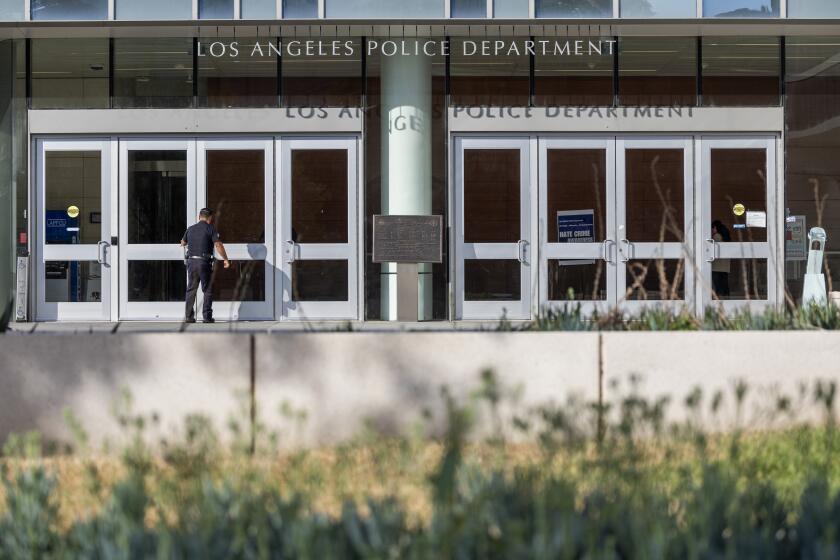Regulators Order L.A., Orange Counties to Cut Fine-Particle Pollution
WASHINGTON — The Environmental Protection Agency declared Tuesday that 13 California counties, including Los Angeles, Orange and San Diego, are shrouded with unhealthy levels of fine particles and must reduce the deadly air pollutants or lose federal funding.
As a result of the EPA requirement, air pollution officials in the greater Los Angeles area must develop detailed blueprints to clean the air of the fine particles, just as they must for ozone, one of the main ingredients of smog.
Nationwide, the EPA concluded that the air in all or part of 243 counties -- home to 99 million people -- contains dangerous levels of particulate matter, tiny flecks as small as one-thirtieth the diameter of a human hair that penetrate deep into the lungs. The EPA has concluded that the particles cause thousands of early deaths in older people and aggravate asthma in children.
The two worst areas in the country were in California: the San Joaquin Valley and the greater Los Angeles area. Except for California, a corner of northwestern Montana and the St. Louis area, all the most polluted counties are east of the Mississippi River.
“Reducing fine particles is the single most important action we can take to make our air healthier for Americans,” EPA administrator Mike Leavitt said.
Leavitt said much of the problem of particle pollution could be solved when two of the EPA’s new programs -- one to clean exhausts from off-road diesel engines and the other to reduce emissions from power plants -- are fully implemented.
However, some California officials said they would need more help from Washington to meet the new standards. They said cars, trucks, planes, trains, ships and many of the other sources of particulate pollution are largely regulated by the federal government.
“We can wipe out our entire share and still not address all of these [particle] emissions,” said Elaine Chang, deputy executive officer of the South Coast Air Quality Management District, the local agency charged with reducing air pollution for 16 million people in the Los Angeles Basin, which includes Orange County and parts of Riverside and San Bernardino counties. “We have more control over ammonia and some other sources ... but we definitely need stronger federal action to attain the new standard.”
Tuesday’s results were preliminary. The EPA will make final decisions on which areas have unhealthful particle levels in November after hearing appeals from the states, which proposed that only 141 counties be on the list.
The states will have until 2008 to develop plans to reduce the airborne flecks. Then they must reduce the fine particles to acceptable levels by 2010, though areas can seek an extension to 2015. Those that fail will risk the loss of federal funds.
For three decades, the federal government has been designating communities that violate health-based standards for smog and soot -- larger particles. But this is the first time it has designated areas that violate the health-based standards for fine particles.
The standards were set in response to research showing that fine particles aggravate lung and heart disease.
But in a case that went to the Supreme Court, a broad coalition of industry groups sued the EPA over the fine-particle standards, delaying implementation of the standards for several years.
Although health concerns provided the primary impetus for reducing fine particle pollution, successful cleanups would also remove much of the haze over cities and rural areas. “The value of this will be seen as well as felt,” Leavitt said.
The San Joaquin Valley and the greater Los Angeles area, covering 12 counties, were the only two regions in the nation that failed both of the standards the EPA used to determine violations, said Wayne Nastri, regional EPA administrator for California and much of the West.
Those benchmarks were an annual average of 15 micrograms of fine particles per cubic meter and a 24-hour average of 65 micrograms. San Diego County also was deemed out of compliance.
State officials had asked the EPA to add Imperial County at the southeast corner of California to the list of violators. But EPA officials concluded that the county passed under both of the benchmarks.
All states with counties on the list will have to show that plans for new roads and public transit systems conform to the air quality goals, and new industrial polluters in the violating areas will be required to use pollution controls. Beyond that, states have leeway to craft solutions to their fine-particle problems.
Although California has a decades-long history of combating air pollution and is ahead of federal standards in many areas, the fine-particle rules probably will require the state to tackle other sources of emissions that it has not focused on in its fight against smog. The solutions may have to be different for separate areas of the state, because the source of the problem varies.
In the heavily urbanized Los Angeles region, 19% of the particles directly emitted into the air come from paved road dust, the EPA said. Pollutants released into the atmosphere also can react chemically to form particles.
Road dust includes soot particles from diesel-burning trucks and buses. Although Southern California officials are taking aggressive measures to reduce diesel pollution in the sources they have authority over, they may have to consider measures such as particle filters to suck up the dust, EPA officials said.
By contrast, in the San Joaquin Valley, historically an agricultural area that has seen a tremendous population spurt in recent decades, 25% of the directly emitted particles come from the burning of farm waste, EPA officials said.
And in San Diego, the biggest direct source is ash and other residue from seasonal wildfires (16%), followed closely by particles from residential fuel combustion involving home uses such as fireplaces. That may require air pollution officials in San Diego to pass restrictions on new wood-burning fireplaces, or to consider incentives for homeowners to swap existing fireplaces with gas-burning models.










